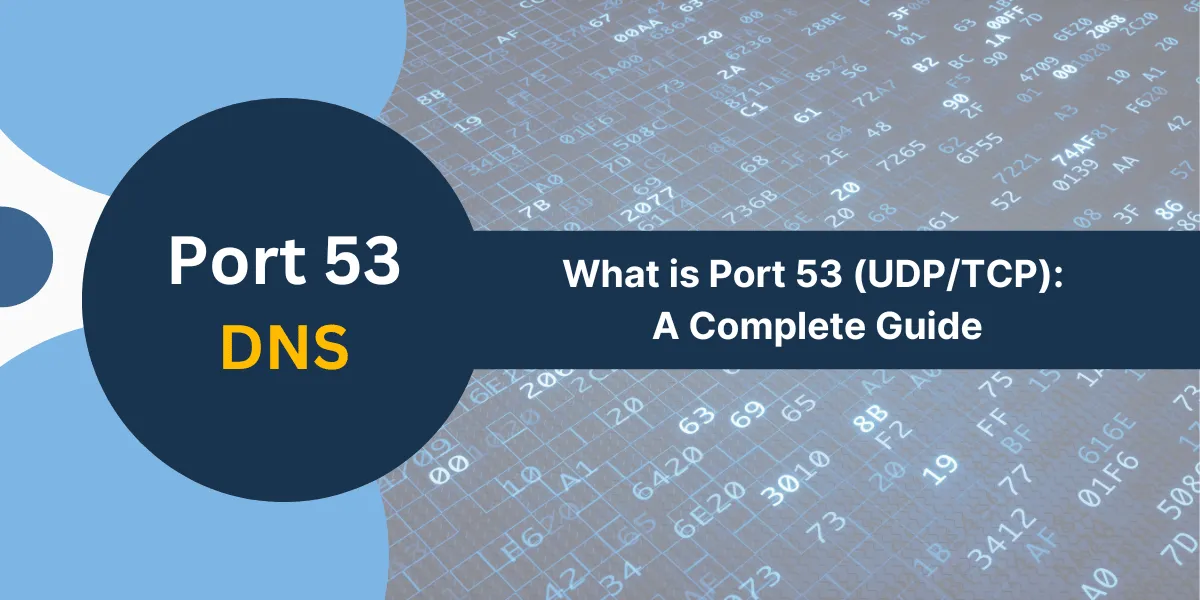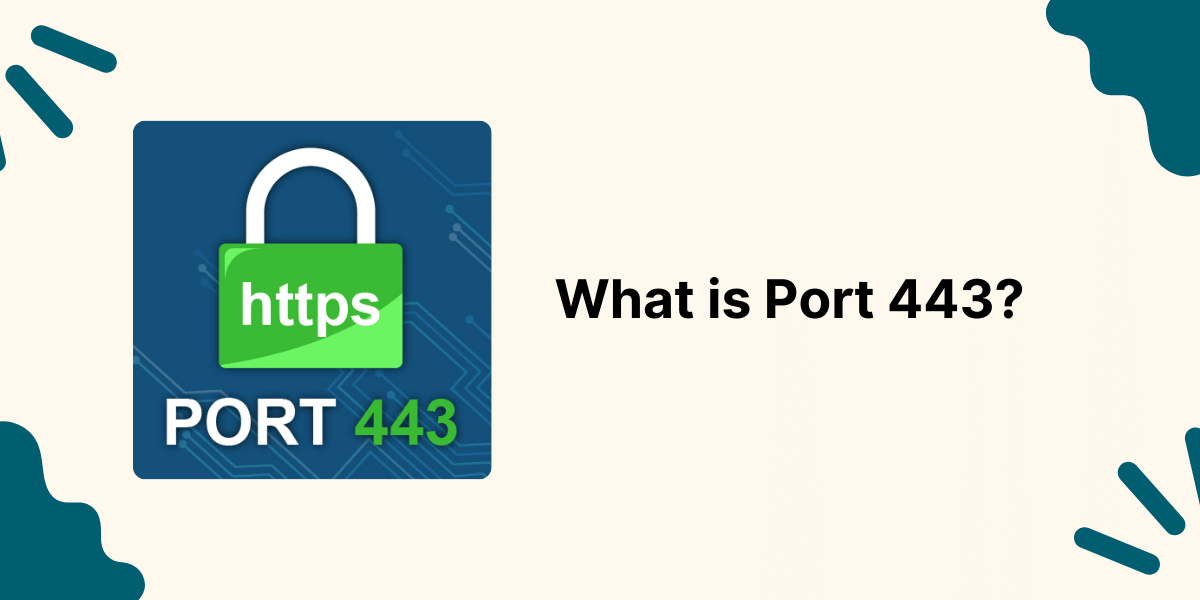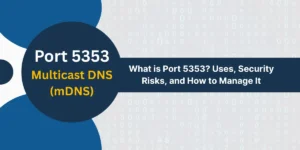Getting Started with Port 53
Port 53 is one of the most important and commonly used ports on the Internet and computer networks. It is the standard port for the Domain Name System (DNS) protocol, which translates domain names into IP addresses. Understanding how Port 53 works and why it is so crucial for network communication is key for network administrators, cybersecurity professionals, and anyone who manages networks and servers.
This comprehensive guide provides an overview of Port 53, how it works, its role in DNS queries, common attacks associated with it, and how to secure it properly.
Key Takeaways
- Port 53 is the standard port for DNS traffic and allows computers to translate domain names into IP addresses through DNS queries.
- It uses both TCP and UDP for communications. UDP is more common for standard DNS queries, while TCP is used for zone transfers between DNS servers.
- Port 53 is susceptible to attacks like DNS cache poisoning, DNS amplification attacks, and DNS spoofing. Proper security measures need to be taken.
- Securing Port 53 includes using firewall rules, DNSSEC, response rate limiting, and patching vulnerabilities. Monitoring traffic and using VPNs also help.
- Proper Port 53 configuration is vital for any network infrastructure. Traffic on this port should be restricted only to authorized DNS servers.
What is Port 53?
Port 53 is a network port in the Transport Layer of the TCP/IP protocol suite. It allows computers to locate websites via their domain names and translate them into IP addresses. It is the standard port used for DNS queries, which makes essential DNS client-server communications possible.
The Domain Name System (DNS) is a hierarchical and decentralized naming system for computers, services, or other resources connected to the internet or a private network. It associates various information with domain names and translates domain names into the numerical IP addresses needed for locating and identifying computer services and devices worldwide.
DNS uses TCP and UDP port 53 for communications and queries between DNS clients and servers. Port 53 allows the client to send requests to the DNS server asking to resolve a hostname or fully qualified domain name (FQDN) into an IP address. The DNS server then responds on port 53 with the corresponding IP address.
Without port 53 and the DNS protocol, you would not be able to access websites by domain names like google.com and instead would have to use their raw IP addresses. The DNS system allows the use of easy-to-remember domain names by mapping them to computer-friendly IP addresses in the background.
How Does Port 53 Work?
Port 53 works by facilitating two-way communication between a DNS client and a DNS server for resolving domain name queries using the DNS protocol. Here is a more detailed breakdown:
- A client computer, such as a PC, server, smartphone, etc., needs to access a particular website or other resource on a remote server.
- It first checks its local DNS cache for any existing mapping of that domain’s name to an IP address. If not found locally, it sends a DNS query request to a DNS recursive resolver server to ask to find the correct IP address for that domain.
- The DNS resolver server then communicates with other DNS servers around the world to recursively query for the authoritative answer until it finds the correct IP address for that domain name.
- The DNS resolver server then sends back the requested IP address to the client using a connection over port 53.
- The client computer then uses this IP address to connect with and access the remote resource over the internet.
- This entire process of resolving domain names to IP addresses uses Port 53 for the queries and responses between the client and the DNS servers.
Some key points about how Port 53 works:
- It uses both UDP and TCP protocols for DNS traffic. UDP is more commonly used for standard DNS queries and responses. TCP over port 53 is used for DNS zone transfers between DNS servers.
- DNS queries are initiated from the client on port 53 to the DNS server, and responses are sent back on port 53 from the DNS server to the client.
- DNS servers have port 53 open and listen for incoming DNS queries. Clients randomly select a port for initiating queries.
- Port 53 is used for resolving both forward DNS queries (domain to IP) and reverse DNS queries (IP to domain).
- Traffic on port 53 is not encrypted by default and can be intercepted. To secure it, encryption like DNSCrypt or DNS over HTTPS (DoH) is used.
What is The Role of Port 53 in DNS Queries
Port 53 plays an indispensable role in enabling DNS queries and responses to translate domain names into IP addresses. Here are some key ways in which it facilitates DNS queries:
- It provides a standard port number for clients to send DNS queries to. Having a dedicated, well-known port for DNS traffic avoids random port allocation.
- Allows clients to locate and send DNS queries to DNS servers for resolution. The servers listen on TCP/UDP port 53 for incoming queries.
- Carries both the DNS queries and responses between the client and DNS resolver/server over UDP and TCP. This bidirectional communication over port 53 is core to DNS functioning.
- It sends DNS queries from clients to a hierarchical distributed network of authoritative DNS servers, ultimately resolving the domain name.
- It returns the IP address of the queried domain name to the client over an established connection on port 53, enabling access to the domain.
- Supports load balancing of DNS queries across multiple servers. DNS clients can send queries to any available server listening on port 53.
- It facilitates communication with backup or secondary DNS servers if the primary server is unavailable. Clients can simply send queries to other servers also listening on port 53.
- It allows DNS service discovery by clients on a network by sending queries to standard port 53 to locate DNS servers.
Without port 53 enabling reliable DNS queries and responses globally, the web would come to a standstill, as clients would not be able to map domain names to website servers.
What are the Common Attacks on Port 53
Despite its critical importance, Port 53 is prone to several security vulnerabilities and configuration issues that make it a common target for malicious attacks and abuse. Some common ways port 53 is attacked include:
- DNS Cache Poisoning: Attackers can inject fake DNS records into a DNS server’s cache, binding popular domain names to the wrong IP addresses. This leads traffic to malicious sites rather than the real domain.
- DDoS Reflection & Amplification: An attacker spoofs the victim’s IP address in DNS queries sent to open precursors, which floods the victim’s network with large responses.
- DNS Hijacking: Malicious parties take over control of the DNS server to redirect traffic to fake IP addresses under their control.
- DNS Tunnelling: Using DNS queries to tunnel and extract data from networks while evading firewalls since they allow port 53 traffic.
- DNS Spoofing: Providing falsified DNS responses to redirect clients to malicious IP addresses impersonating legitimate sites and services.
- Domain Shadowing: Exploiting domains with low security to create subdomains that mimic targeted domains but lead to phishing sites.
- Botnet Communication: Botnets make DNS queries over port 53 appear like normal traffic, allowing covert communication between infected machines.
- Data Exfiltration: Using DNS queries to covertly extract and send data from compromised networks by encoding it in DNS requests.
- Zone Enumeration: Incrementing domain names in DNS queries to gather information on sub-domains and network resources.
How to Secure Port 53 Traffic
Since port 53 is so vulnerable to exploitation, it is crucial to take measures to lock it down.
Here are some key ways to secure port 53 traffic:
- Use firewall rules to restrict UDP/TCP port 53 to authorized DNS servers and block all other access. This will limit the attack surface.
- Enable DNS response rate limiting on DNS servers to protect against reflection attacks and abusive queries. Discard queries exceeding a threshold.
- Validate DNS queries coming from unknown or suspicious sources before responding and filtering accordingly. Prevents spoofing.
- Use DNSSEC on servers to digitally sign records, preventing tampering and forgery. DNSSEC validation on clients also protects against spoofing.
- Update DNS server software regularly to patch vulnerabilities. Keep all DNS infrastructure up-to-date.
- Monitor network flows for abnormal DNS traffic volumes, queries to suspicious domains, and other abnormal activity.
- Use VPNs for secure and encrypted DNS query transport from clients to DNS servers. Prevents eavesdropping and data extraction.
- Leverage DoH (DNS over HTTPS) to encrypt DNS queries and prevent inspection, spoofing, and manipulation.
- Use technologies like DNSCrypt that authenticate and encrypt communications between DNS clients and servers.
- Implement advanced threat detection systems to identify any malicious use of DNS infrastructure.
How to Configuration Port 53
As port 53 is a vital network service, it is paramount to configure it correctly for both security and availability. Here are some guidelines for proper configuration:
- Restrict access to DNS servers only. Use firewalls and ACLs to allow authorized DNS resolver servers to send/receive traffic on port 53. Block all other systems.
- Allow queries from authorized clients: Permit DNS queries originating from known subnets and IP ranges. Block queries from suspicious sources.
- Disable open recursion: Respond to DNS queries only from authorized sources to prevent DDoS amplification attacks.
- Enable DNSSEC: Digitally sign DNS records and validate responses to prevent spoofing and manipulation.
- Update DNS software: Keep DNS server software patched and up-to-date to eliminate vulnerabilities.
- Set up secondary DNS servers: Configure backup DNS servers to ensure redundancy and high availability of DNS services if the primary server goes down.
- Load balance incoming queries: Spread DNS queries across multiple servers to optimize performance.
- Use connection rate limiting: Limit the number of connections per client IP to prevent abusive volumes of queries.
- Monitor DNS traffic: Analyze DNS flows to identify any anomalous activity or attacks.
- Encrypt DNS traffic: Implement DoH, DNSCrypt, or other technologies to encrypt DNS queries and prevent snooping.
- Authenticate queries: Consider using TSIG to sign DNS queries between authorized servers cryptographically.
Final Thoughts
Port 53 is the fundamental port that makes DNS functionality possible by enabling clients to resolve domain names into IP addresses through DNS queries. Proper configuration and securing of port 53 is necessary to prevent misuse while allowing legitimate name resolution traffic.
Implementing firewall policies, DNS infrastructure hardening techniques, encryption mechanisms, and actively monitoring DNS traffic are all crucial to protect networks from the numerous attacks that abuse port 53 vulnerabilities. Network administrators and security professionals need to follow best practices to keep this vital port for DNS communication both accessible and secure.
Frequently Asked Questions about Port 53
What protocols does Port 53 use?
Port 53 uses both UDP and TCP protocols. UDP is more commonly used for standard DNS queries and responses, while TCP enables zone transfers between DNS servers.
Is Port 53 UDP or TCP?
Port 53 uses UDP predominantly but also supports TCP. UDP is used for most DNS client queries and server responses. TCP enables zone transfers between DNS servers.
Why is Port 53 important?
Port 53 is vital for DNS’s functioning and mapping domain names to IP addresses. It enables clients to send DNS queries and receive the responses needed to access websites and other internet resources using human-friendly domain names.
Is Port 53 open or closed by default?
Port 53 is open by default on all systems to allow DNS traffic to flow for name resolutions. On DNS servers, it is open and listening for queries. Clients initiate queries randomly to port 53.
Can I block Port 53?
You can block port 53 for all systems except authorized DNS servers. However, doing so will break all DNS functionality and name resolutions. It is better to restrict access to only legitimate DNS traffic.
Is Port 53 secure?
No, plain DNS traffic over port 53 is unencrypted and insecure. It is susceptible to attacks like snooping, spoofing, and interception. To secure port 53, it is recommended that DNS queries be encrypted using VPNs, DNSCrypt, DoH, etc.
How do I harden Port 53 security?
Use firewall rules, enable DNS response rate limiting, implement DNSSEC, regularly update DNS software, monitor traffic for anomalies, use VPNs for clients, and leverage DNS encryption solutions like DNSCrypt or DoH to harden port 53 security.
What happens if Port 53 is blocked?
Blocking UDP/TCP port 53 will completely break DNS functionality and prevent name resolutions for clients. Websites, email services, network tools, and other services relying on DNS will stop working.
How do I troubleshoot Port 53 issues?
Use network scanners to verify port 53 is open on DNS servers, check firewall rules to ensure it is not blocked, confirm the DNS service is running, look for anomalies in traffic or logs, enable debug logging on DNS servers, and trace DNS queries using tools like Wireshark and dig.
What tools can analyze Port 53 traffic?
Tools that can analyze Port 53 (DNS) traffic include network sniffers like Wireshark, network monitoring tools like Nagios, and specialized DNS analysis tools like DNSInspect and DNSQuerySniffer.

Priya Mervana
 Verified Web Security Experts
Verified Web Security Experts
Priya Mervana is working at SSLInsights.com as a web security expert with over 10 years of experience writing about encryption, SSL certificates, and online privacy. She aims to make complex security topics easily understandable for everyday internet users.



